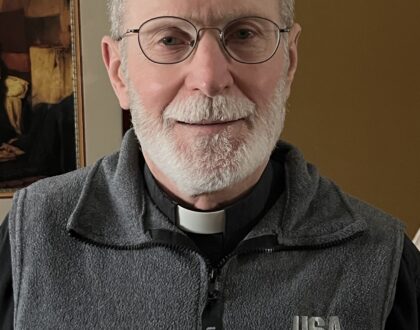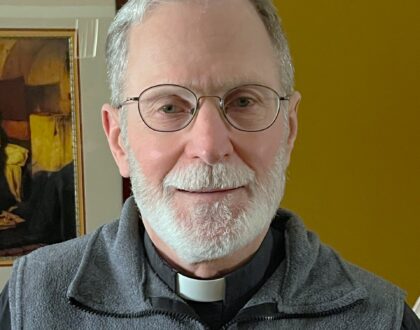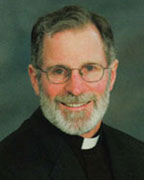Homily, July 16, 2023

From The Pastor
A month ago, the question was raised as to whether we should return the tabernacle to the sanctuary in Church. Discussions were had with the Adult Faith Formation commission, the Evangelical Charity Commission (formerly Christian service) and staff. In this year of Eucharist Renewal there was strong interest in this significant liturgical change.
Why the change and what does it mean? Following the conclusion of Vatican II, liturgical reforms included Mass in English with the priest facing the people. A more communal aspect of our gathering became the new focal point. Tabernacles were more often located in a side or daily Mass chapel, including space for reservation and adoration of the Sacrament. The focal point of the sanctuary has always been the altar upon which the living sacrifice of the Mass is offered. This remains the case today.
Why move the tabernacle now? Recent movements of liturgical practice have shown a renewed interest in having the tabernacle present in the main sanctuary. Church renovations or new builds are directed to locate the tabernacle in the main worship space. A primary motivation for us is to take advantage of this Eucharistic year of renewal in rebuilding the faith and reverence of the faithful in the Real Presence of the living Christ.
What does this mean for us practically? In the next few weeks, determined by the metrics and preparation needed, the tabernacle will be moved to the center of the main sanctuary space. While the altar remains the central focus as the table of sacrifice, the tabernacle is intended to enrich and focus our attention on the presence of the Lord as we prepare for Mass. This greater reverence and attention will necessarily include a greater reverence as we enter the church. A reverent bow or genuflection is most appropriate. Similarly, greeting one another and talking in church should become softer with attentive awareness of the presence of the Lord among us. Those seeking to pray should be able to do so without intrusive conversations. If it is evident a person is praying, conversations should seriously tone down or move to a more appropriate space.
This does not mean we return to the silence of the 1950’s. It does mean that we are aware and attentive to the presence of the Lord as we enter church in preparation for Mass. Greeting one another is an important part of our community life. It should remain so in a quieter and more reverent tone.
Through the course of the year, I intend to preach on Eucharistic themes that reveal the meaning and power of this living Sacrament of the Lord’s presence. One example is that it is not uncommon that when we think of Jesus at Mass, on the altar, or in receiving our personal communion, we imagine Jesus on the Cross or in his dying. This is not wrong, because the death of Jesus on the Cross was real. He was crucified and he died. However, in the sacrifice of the Mass what we consecrate from simple bread and wine is the living, resurrected Christ. On the altar, through the consecration, the real living presence of the risen Lord is made present. He is not dead. He is alive and enthroned in heaven with the heavenly Father.
The risen Christ is no longer limited by time and space. Jesus is now eternal, ever-present in all time and in every place. The holy sacrifice of the Mass makes present the power of Good Friday in the dying of Jesus for the forgiveness of sins. On the altar through the calling down of the Holy Spirit, the living presence of the Resurrected Lord is made present. This is the power of the Sacrament that sustains us in faith. As we receive communion, we are consuming, taking into ourselves the living presence of the Risen Christ.
This is not a passive interaction. It is a mutual sharing of communion. As we receive in faith and reverence the living Christ, we are also received by Jesus into himself. This is what makes it communion; the mutual sharing and receiving of the other in a sacred exchange. This is the exchange and interaction of the Last Supper on Holy Thursday. It was living and real. Jesus loved his followers and never wanted to leave them. In the breaking of the bread and sharing of the cup, Jesus transforms bread and wine into his body and blood in a Sacrament that will endure until the end of the world. This Sacrament is a bond of love and commitment by Jesus that will never be broken. The life and person of Jesus is always with us and never more perfectly than in the Sacrament of the Holy Eucharist.
Please consider these changes and pray for the graces that will come to us in this exchange. Please pay attention to our upcoming offerings to enrich this year of renewal of the Holy Eucharist. Ask God to bless our gathering with a renewed and shared reverence for Jesus and one another as we enter our sacred space at Mass. Let the seed of the Eucharist that is Jesus, bear fruit in you at thirty or sixty or a hundred-fold. Imagine that! Be Jesus. Be Eucharist for others.
Father John Esper
Recent Sermons

Homily, April 6, 2025
April 05, 2025

Homily, March 30, 2025
March 27, 2025

Homily, March 23, 2025
March 20, 2025

